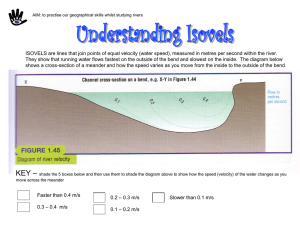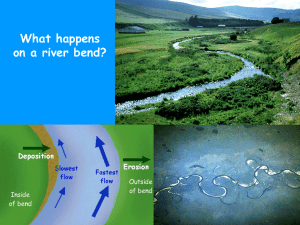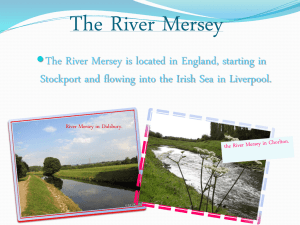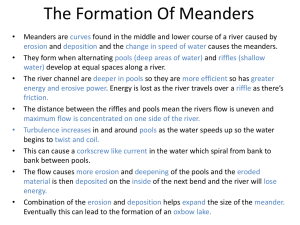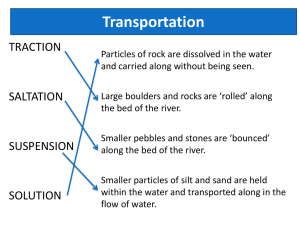Meanders and Ox-Bow Lakes
advertisement
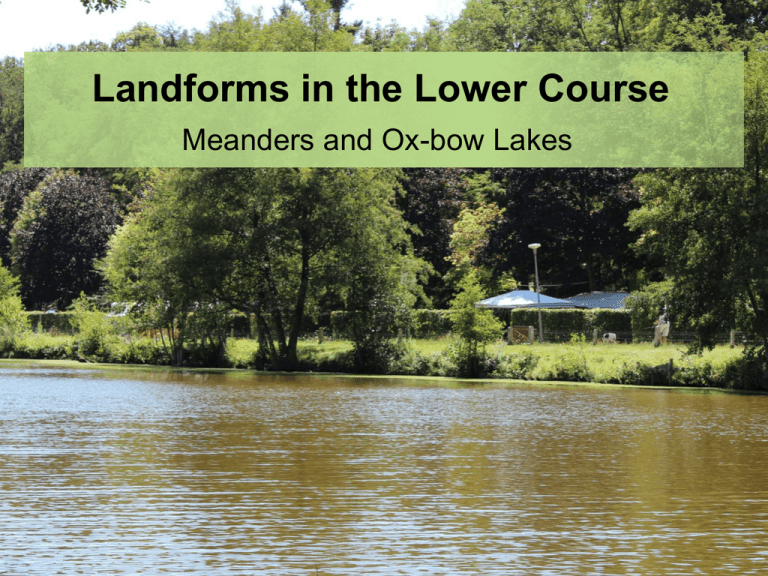
Landforms in the Lower Course Meanders and Ox-bow Lakes Lesson Objectives You should be able to: • describe and explain the asymmetrical shape of the channel cross-section across a meander. • explain how an ox-bow lake is formed. Asymmetrical Shape 3 (c) (ii) Suggest reasons for the shape of the river cross section between P and Q. (2) • (There should be recognition of the asymmetrical shape of the cross section, with a steep sided river cliff on the outer bank and gentler slip-off slope on the inner bank). • The faster flow of water (helicoidal flow) on the outer bend of the meander (1), causes more erosion and undercutting of the bank (1). Slower flow on the inner bend (1) may lead to deposition of material (1). Credit a labelled diagram if it helps to explain the cross section. (2 marks) • Need to refer both sides of channel for 2 marks. Meander Bend on the River Conwy Explain why there is more deposition at A than at B. (3) CONVEX - A Slow Shallow Deposition Slip-off Slope VARIABLES CONCAVE - B SPEED OF FLOW Fast DEPTH Deep PROCESSES FEATURE Erosion River Cliff Explain why there is more deposition at A than at B. (3) Explain why there is more deposition at A than at B. (3) Explain why there is more deposition at A than at B. (3) • A* Knowledge: • The force that pushes the river’s water towards the outer bank on a bend is called centrifugal force. (It’s the same force that throws you outwards on a roller coaster or roundabout) • Eroded material on one meander is transported across the channel to be deposited on the beach/slip-off slope of the next meander by helicoidal/helical flow. (This is a ‘corkscrew’ motion that sometimes creates little whirlpools on the river’s surface) Questions on Meanders • What is a meander (1) • Draw and label a cross-section from A – B through the meander. (3) • Explain how the features of a meander are formed. (4) What is a meander (1) • A meander is a winding curve or bend in a river. Different questions may require the same information. • Give reasons for the formation of meanders. • Briefly state why meanders form. • Account for one feature found in the middle/lower course of a river. (2-4) • A meander is a winding curve or bend in a river. They are typical of the middle and lower course of a river. This is because vertical erosion is replaced by a sideways form of erosion called LATERAL erosion, plus deposition within the floodplain. Questions on Meanders • What is a meander (1) • Draw and label a cross-section from A – B through the meander. (3) • Explain how the features of a meander are formed. (4) Draw and label a cross-section from A – B through the meander. (3) Questions on Meanders • What is a meander (1) • Draw and label a cross-section from A – B through the meander. (3) • Explain how the features of a meander are formed. (4) Explain how the features of a meander are formed. (4) • The major features found on a meander are river cliffs and slip-off slopes. A river cliff forms on the outside of a river bend as a result of faster flowing water and its load causing erosion and undercutting the river bank. A slip off slope forms on the inside of a river bend where the river is flowing more slowly and deposition takes place. 1 (a) Describe how a river erodes material from its bed and banks (3) • • • • • • Hydraulic action, abrasion and corrosion/solution are the relevant processes. There should be reference to how the processes work: Hydraulic action is the removal of material by the sheer force of water. The turbulent flow of the water picks up loose material due to frictional drag. The higher the velocity – the more effective the process. Abrasion occurs when material being carried by the river hits the bed and banks and so wears them away via a scouring/sandpapering effect. The load used for this purpose will vary in size. Corrosion is the removal of certain rocks in solution – such as chalk and limestone where the mineral mixes with the rainwater and is carried away within it. Allow 1 mark for a list of two or more terms. 3 x 1 1 (a) Describe different types of load a river carries. (4) • There are three types of load – bedload, suspended load and dissolved load. • Bedload consists of that which remains on the bottom of the river channel and represents the largest material, such as cobbles and boulders. At times of lower flow, it also includes smaller particles, including sand¹. • Suspended load is that held within the body of the water and includes smallest and smaller particles of clay, silt and sand, depending on the speed of the water. 1 (a) Describe different types of load a river carries. (4) • Dissolved load is that which is held in solution where certain types of rock such as chalk and limestone are present within the water, thus are not visible. • Allow 1 mark for a list of either types (two or more) and size (two or more) if different sizes identified e.g. clay and boulders, a further mark is available for an accurate figure indicating size of each e.g. 0.001 and 600mm. 4×1 (4 marks) River Competence vs Capacity At times of lower • This point in the answer flow, it also refers to the competence includes smaller of the river i.e. the largest particles, sized particle the river is including sand¹. able to carry. Competence varies with energy. Thus, when there is low flow in the river, energy is lower and competence falls. Study the figure below, a photograph which shows part of a river meander. (7) Draw a simple cross-section across the meander, and mark and label a river-cliff and the slip-off slope. (3) River Cliff Slip-off Slope Explain why the meander crosssection has this shape. (4) • The meander cross-section is asymmetrical. The river cliff is formed on the outer bend of the meander. This is where the water is deeper and moves faster. Hydraulic action and abrasion wear away at the side of the channel, undercutting the river bank to form a river cliff. • On the inside bend of the meander, the water is shallower and moves more slowly. As a result the river’s load is deposited to form a gentle slope called a slip-off slope composed of alluvium. Explain the formation of ox-bow lakes. OX-BOW LAKES Stages in ox-bow lake formation Stages in ox-bow lake formation Wavelength and amplitude of meanders increase downstream because of erosion and deposition. With the aid of diagrams, explain the formation of an oxbow lake. (6 marks) An ox-bow lake is a crescent/horseshoe-shaped lake found on a river’s floodplain in its lower course. As the river meanders across the valley, it erodes laterally and deposits as well. In a meander the thalweg is close to the outside bend. A faster, helicoidal flow causes erosion of this bank through hydraulic action and abrasion – undercutting the concave bank to form a river cliff. Shallower water, greater friction and lower velocity results in deposition on the convex inner bend and the formation of a slip-off slope. This combination of lateral erosion on the outside and deposition on the inner bend causes meander wavelength and amplitude to increase downstream. With the aid of diagrams, explain the formation of an oxbow lake. (6 marks) Over time the size of the meander increases such that a narrow piece of land is all that separates two adjacent concave meander loops. This is called the meander neck. Erosion gradually narrows the meander neck until, during a flood, the river breaks through and flows along a straighter and shorter course, forming a meander chute and cut-off. The old meander will contain water but will eventually be abandoned as new deposition seals of the ends to form an ox-bow lake. Over time further deposition will fill in the ox-bow lake to form a meander swamp and then a meander scar. With the aid of diagrams, explain the formation of an oxbow lake. (6 marks) Photo of an old meander in England. Deposition has almost filled in the ox-bow lake and will eventually form a meander scar. At this meander, the neck is very narrow. An ox-bow lake should form at the next flood. Cocha Brasko and Rio Manu at confluence with Rio Pinquen in lowland tropical rainforest, Manu National Park, Madre de Dios, Peru. Ox-Bow Lake in Butterby, UK Ox-Bow Lake Undercut Bank Oxbow Lake Old Channel Slip-off Slope & Point Bar Channel Meander along the Sacrament River Formation of an Oxbow Lake


